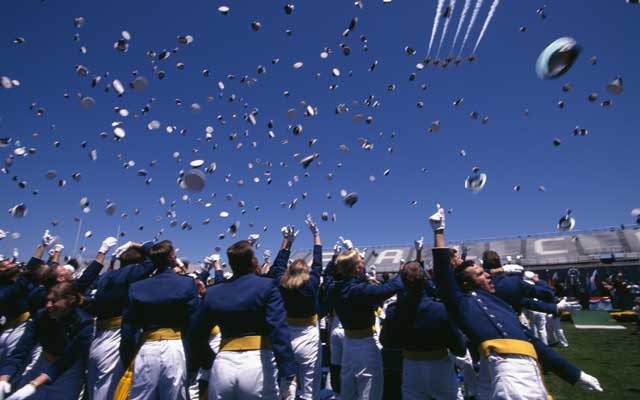Air Force Celebrates 66th Birthday
Emil Maine /

The United States Air Force (USAF) Thunderbirds fly over as USAF Academy Cadets toss their caps in the air at the completion of graduation ceremonies. (James Frank Stock Connection Worldwide/Newscom)
Today we celebrate the 66th birthday of the United States Air Force (USAF).
The USAF has much to boast. It developed aerial combat and produced the nation’s first flying Ace. In World War I, it conquered the skies of Western Europe. In June 1942, it accomplished the inconceivable by flying land-based bombers off a 700-foot aircraft carrier—one-fourth the required take-off distance—and did it 16 times.
Today, however, the Air Force is at a turning point. Despite several major engagements since the end of the Cold War—including Afghanistan, Iraq, Kosovo, and Libya—the Air Force currently operates the oldest fleet it has ever had. Two decades of underinvestment threaten the future of modernization plans, driving up operations and maintenance costs and preventing the United States from building the Air Force that the country needs for the future.
The Air Force fleet is becoming inadequate to support U.S. national security interests, too. Since 2001, the number of Air Force fighters has fallen by about 25 percent. The Air Force has 372 fewer F-16s, 263 fewer F-15s, and 52 fewer F-117s than were in the inventory in 2001—and no modern strategic bombers. The bulk of the bomber fleet comprises B-52s that were first commissioned over 60 years ago.
The USAF faces readiness problems that undermine its ability to provide for the nation’s security. Air Force Chief of Staff Mark Welsh recently told U.S. airmen stationed in Japan that if the President takes action in Syria, the Air Force and the services will carry out their assigned missions, but “we are not going to be as ready as we would like.”
History repeatedly shows that unanticipated events often catch us by surprise and that, as a nation, we have paid a high price in blood and treasure to compensate for our lack of preparedness.
The USAF boasts four pillars of helping to provide for the nation’s security:
- Gaining control in air, space, and cyberspace;
- Holding targets at risk anywhere in the world;
- Providing responsive intelligence, surveillance, and reconnaissance; and
- Rapidly transporting people and equipment around the world.
Without the USAF, the U.S. would not be able to move troops and equipment to war zones, send relief to countries devastated by natural disasters, provide air support to troops on the ground, or gather crucial intelligence through electronic warfare and stealth technology.
Therefore, as we celebrate today’s anniversary, let’s remember that the USAF’s contribution to the nation’s security can’t be taken for granted.
